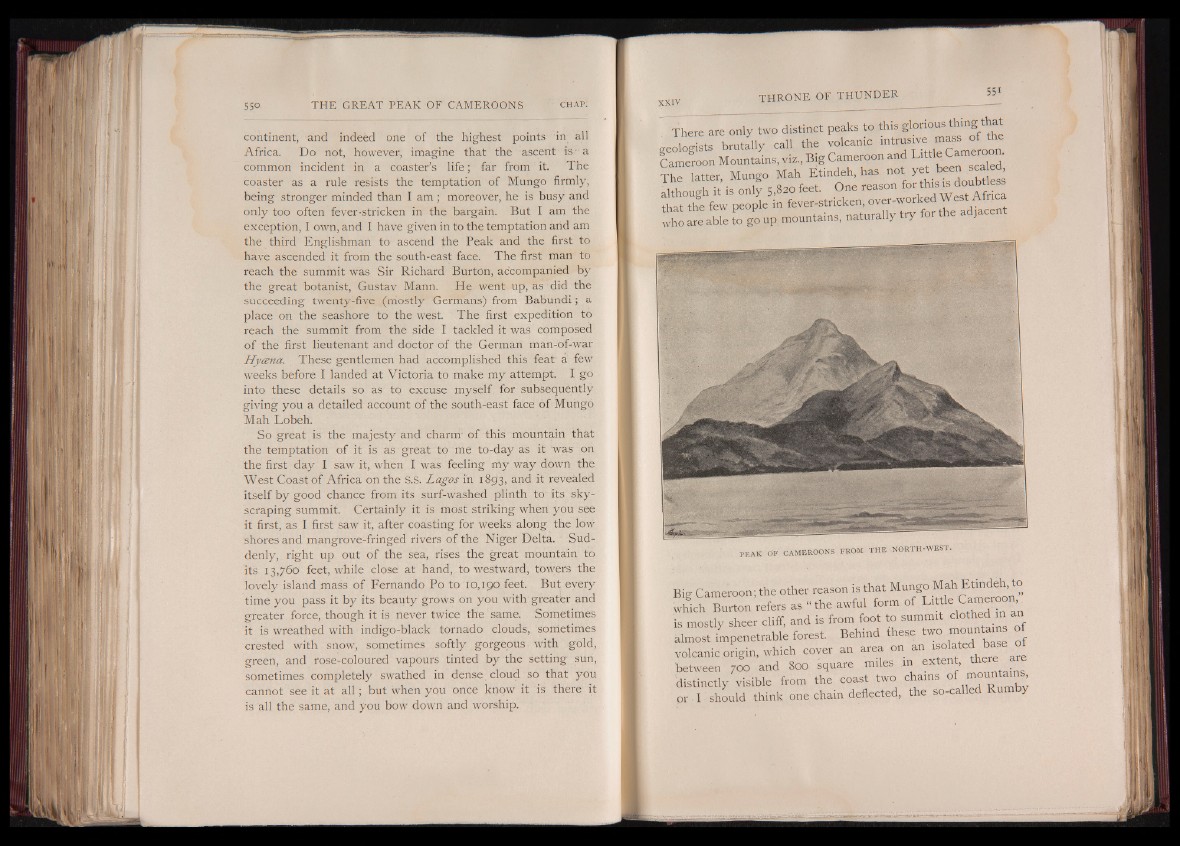
continent, and indeed one of the highest points in all
Africa. Do not, however, imagine that the ascent is- a
common incident in a coaster’s life ; far from it. The
coaster as a rule resists the temptation of Mungo firmly,
being stronger minded than I am ; moreover, he is busy and
only too often fever-stricken in the bargain. But I am the
exception, I own, and I have given in to the temptation and am
the third Englishman to ascend the Peak and the first to
have ascended it from the south-east face. The first man to
reach the summit was Sir Richard Burton, accompanied by
the great botanist, Gustav Mann. He went up, as did the
succeeding twenty-five (mostly Germans) from Babundi; a
place on the seashore to the west. The first expedition to
reach the summit from the side I tackled it was composed
of the first lieutenant and doctor of the German man-of-war
Hycena. These gentlemen had accomplished this feat' a few
weeks before I landed at Victoria to make my attempt. I go
into these details so as to excuse myself for subsequently
giving you a detailed account of the south-east face of Mungo
Mah Lobeh.
So great is the majesty and charm' of this mountain that
the temptation of it is as great to me to-day as it ‘was on
the first day I saw it, when I was feeling rrty way down the
West Coast of Africa on the S.S. Lagos in 1893, and it revealed
itself by good chance from its surf-washed plinth to its sky-
scraping summit. Certainly it is most striking when you see
it first, as I first saw it, after coasting for weeks along the low
shores and mangrove-fringed rivers of the Niger Delta. Suddenly,
right up out of the sea, rises the great mountain to
its 13,760 feet, while close at hand, to westward, towers the
lovely island mass of Fernando Po to 10,190 feet. But every
time you pass it by its beauty grows on you with greater and
greater force, though it is never twice the same. Sometimes
it is wreathed with indigo-black tornado clouds, sotrietimes
crested with snow, sometimes softly gorgeous with gold,
green, and rose-coloured vapours tinted by the setting sun,
sometimes completely swathed in dense cloud so that you
cannot see it at a ll; but when you once know it is there it
is all the same, and you bow down and worship.
THRONE OF THUNDE■R
There are only two distinct peaks to this glorious thing.that
geologists brutally call the volcanic
Cameroon Mountains, vis., Big Cameroon and
The latter Mungo Mah Etindeh, has not yet been sea e ,
aldaough it is only 5,820 feet. One reason
that the few people in fever-stricken, over-worked We
S are able to go up mountains, naturally b y for the adjacent
PEAK O'F CAMEROONS FROM THE NORTH-WEST.
Big Cameroon; the other reason is that Mungo Mah Etindeh, to
w h ic h Burton’refers as “ the awful form of Little Cameroon^
is mostly sheer cliff, and is from foot to summit
almost impenetrable forest. Behind these two mountmns of
volcanic origin, which cover an area on an iso , g are
between 700 and 800 square miles in ex e , |
distinctly visible from the coast two c k m s o ,